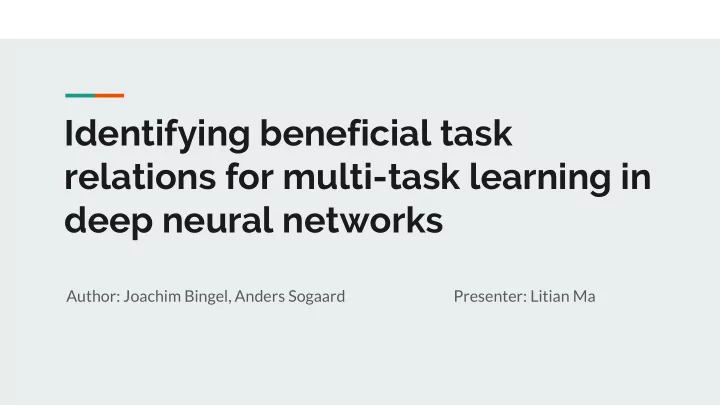

Identifying beneficial task relations for multi-task learning in deep neural networks Author: Joachim Bingel, Anders Sogaard Presenter: Litian Ma
Background Multi-task learning (MTL) in deep neural networks for NLP has ● recently received increasing interest due to some compelling benefits It has potential to efficiently regularize models and to reduce the need ● for labeled data. The main driver has been empirical results pushing state of the art in ● various tasks. In NLP, multi-task learning typically involves very heterogeneous ● tasks.
However ... While great improvements have been reported, results are also often ● mixed . Theoretical guarantees no longer apply to the overall performance. ● Little is known about the conditions under which MTL leads to gains in ● NLP. Want to answer the question: ● What task relations guarantee gains or make gains likely in NLP?
Multi-task Learning -- Hard Parameter Sharing Extremely popular approach to ● multi-task learning. Basic idea: ● Different tasks share some of the ○ hidden layers , such that these learn a joint representation for multiple tasks. Is considered as regularizing target ○ model by doing model interpolation with auxiliary models in a dynamic fashion.
MTL Setup Multi-task learning architecture: Sequence labeling with recurrent ● neural networks With a bi-directional LSTM as a single hidden layer of 100 dimensions ● that is shared across all tasks. Input ot the hidden layer: 100-dimensional word vectors pre-trained ● by GloVe embeddings. Generates predictions from the bi-LSTM through task-specific dense ● projections. The model is symmetric in the sense that it does not distinguish ● between main and auxiliary tasks.
MTL Training Step A training step consists of: ● Uniformly drawing a training task ○ Sampling a random batch of 32 examples from the task’s training ○ data. Each training step works on exactly one task, and optimizes the ● task-specific projection and the shared parameters using Adadelta. Hyper-parameters are fixed across single-task and multi-task settings. ● Making our results only applicable to the scenario where one ○ wants to know whether MTL works in the current parameter setting.
Ten NLP Tasks CCG Tagging ( CCG ) Hyperlink Prediction ( HYP ) ● ● Chunking ( CHU ) Keyphrase Detection ( KEY ) ● ● Sentence Compression ( COM ) MWE Detection ( MWE ) ● ● Semantic frames ( FNT ) Super-sense tagging ( SEM ) ● ● POS tagging ( POS ) Super-sense Tagging ( STR ) ● ●
Experiment Setting Train single-task bi-LSTMs for One multi-task model for each ● ● each of the ten tasks. of the pairs between the tasks, Trained 25000 batches. yielding 90 directed pairs of the ● form. Trained 50000 batches to ● account for the uniform drawing of the two tasks at every iteration.
Relative Gains and Losses 40 out of 90 cases show improvements ● Chunking and high-level semantic ● tagging generally contribute most to other tasks, while hyperlinks do not significantly improve any other task. Multiword and hyperlink detection ● seem to profit most from several auxiliary tasks. Symbiotic relationships are formed ● e.g., by POS and CCG-tagging, or MWE ○ and compression.
Predict gains from MTL Dataset-inherent features + learning curve feature. ● Learning curve feature : ● Gradients of the loss curve at 10, 20, 30, 50, and ○ 70 percent of 25000 batches. Steepness of the Fitted log-curve (parameter a ○ and c): Each of 90 data points is described by 42 features. ● 14 features each task. ○ main, auxiliary, and main/auxiliary ratios . ○ Binarize the experiment results as labels. ● Use logistic regression to predict benefits. ●
Experiment Results A strong signal in meta-learning features. ● The features derived from the single task ● inductions are the most important. Only using data-inherent features, F1 ○ score is worse than the majority baseline.
Experiment Analysis
Experiment Analysis Features describing the learning curves for the main and auxiliary ● tasks are the best predictors of MTL gains. The ratios of the learning curve features seem less predictive, and the ● gradients around 20-30% seem most important. If the main tasks have flattening learning curves (small negative ● gradients) in the 20-30% percentile, but the auxiliary task curves are still relatively steep, MTL is more likely to work. Can help tasks that get stuck early in local minima . ○
Key Findings MTL gains are predictable from dataset characteristics and features ● extracted from the single-task Inductions The most predictive features relate to the single-task learning curves, ● suggesting that MTL, when successful, often helps target tasks out of local minima . Label entropy in the auxiliary task was also a good predictor; but there ● was little evidence that dataset balance is a reliable predictor, unlike what previous work has suggested.
Thanks!
Recommend
More recommend